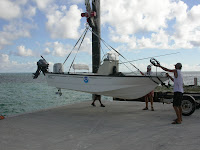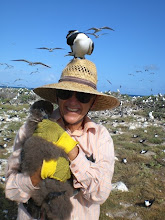Sunday, July 27, 2008
Day Off
Saturday, July 26, 2008
Biology Projects
Friday, July 25, 2008
Frigatebird Glutton
Thursday, July 24, 2008
Thursday on Tern Island
Today was a mixed bag of work. I began the day banding Masked Booby chicks. The chicks are larger than a Mallard duck and are nearly ready to fledge. They are fish eaters and have sharp serrated beaks so some care is required catching and restraining them for banding. While we were banding the MABO chicks a Red-footed Booby landed on my head and sat there for several minutes. I have Sooty Terns roost on my head every day that I work in the colonies but this is the first time a Red-footed Booby has ever roosted on my head. The simple pleasures continue here on Tern. One of the turtle techs has left for home and the other one, Tammy, is banding hatchling turtles. The hatchlings are smaller in diameter than a tennis ball and only about ¾ of an inch thick. The bands are tiny and clip on the right front flipper. It was interesting to watch the process. We will see many more as the program hopes for 400 banded hatchlings. The rest of the day was spent working on maintenance projects and doing 3 loads of house laundry. Just like home.
Wednesday, July 23, 2008
Life on Tern Island
Our Internet use has been so restricted it is hard to keep up this blog. I will continue with small posts but I still can't use pictures. The biology is slowing down with most of the nesting activity finished. I still see new nests occasionally in my Red-footed Booby and Red-tailed Tropicbird plots but they are rare. I still monitor these plots every other day but the numbers of birds are way down. The biggest job left for me is banding about 130 Red-footed Booby chicks that will fledge within the next 3 weeks. We continue to have rainy days every few days so our water storage looks good. I have enjoyed my time here immensely but I can see the end coming.
Saturday, July 19, 2008
Saturday on Tern Island
Friday, July 18, 2008
Moon Shadows
Thursday, July 17, 2008
Tiger Sharks and Albatross Chicks
Tuesday, July 15, 2008
Changing Blog
Saturday, July 12, 2008
East Island Turtle Camp Switch
Friday, July 11, 2008
Turtle Barriers




Green Sea Turtles are strong persistent animals and can get themselves into dangerous situations around the buildings and runway on Tern Island. They crawl up on the beaches, usually during the nighttime hours, to dig their nests and lay eggs. If they leave their nest and crawl into a situation where they are trapped and exposed to the daytime heat they will die. To prevent this, turtle barriers have been built over the years to stop the turtles from getting themselves into dangerous situations. The barriers have been built where turtles are known to escape the beaches and get entrapped. They take many forms and the pictures in this post show most of the types. The turtles move lots of sand so we need to shovel the sand away from the barriers regularly or the turtles will crawl up the ramps of sand they have piled up and crawl over the barriers. ---Notice the height of the sand piles beyond the albatross chick and the wood barrier.---
Thursday, July 10, 2008
Tern Island Without the Albatross


Wednesday, July 9, 2008
The Boat Hoist

 This sequence shows taking a boat out of the water. This process happens almost every day and usually several times per day. The boat is lifted straight up and then is swung around onto the concrete apron and lowered onto its trailer so it can be rolled out of the way for other boats to be launched or retrieved.
This sequence shows taking a boat out of the water. This process happens almost every day and usually several times per day. The boat is lifted straight up and then is swung around onto the concrete apron and lowered onto its trailer so it can be rolled out of the way for other boats to be launched or retrieved.


The Biologist and the Birder


After spending 3 months on Tern Island working as a Field Biology Technician, I'm beginning to see differences between a biologist and a birder. I've spent 30 years as a birder and most of what I've done as a birder in those 30 years, involved observing and thinking about individual birds. The albinos in the previous post are a good example. That kind of variation is fascinating to me. Steve, the biologist that I'm working for, had a passing interest when we showed him the 2 albino chicks but he didn't even take pictures. His interest, as a field biologist, is the population. One pure white, pink eyed, Brown Noddy chick, that probably won't survive, has very little biological meaning. It is a genetic mistake that occurs rarely, but consistently, and is interesting only for it's rarity. It has very little meaning to the total population of Brown Noddys.
Caption: Sooty Terns at the top, Brown Noddys at the bottom
Albino and Partial Albino




In the past 2 days we have discovered 2 color variant birds. One is a Sooty Tern chick which is a partial albino that is mostly white but has some color in the eyes and bare skin parts and a dark wash on it's feathers. The bottom picture, which shows the partial albino Sooty Tern chick has a normal colored chick in the bottom right to give a good color comparison. The black and white bird in the upper left in the same photo, is an adult Sooty Tern. The true albino is a Brown Noddy chick and the picture shows it with the adult Brown Noddy.
Monday, July 7, 2008
Whale-Skate Snorkel Trip
Sunday, July 6, 2008
Birthdays

I have been blessed with many interesting and memorable birthdays. There have been at least 5 birthdays on backpacking trips. The first back country birthday I remember was near Bench Lake in Kings Canyon N.P. about 1966. Jack brought in lots of goodies for us to eat. There were at least 2 up the Deer Cove Trail in Kings Canyon with Jan, Hannah, Jens, and again Jack. There were 2 in Big Whitney Meadow just south of Mount Whitney. There was one in Voss, Norway with a newly met cousin on my Moms side of the family. There was even one in Buffalo. Now here is another memorable birthday on Tern Island in the mid Pacific. Monica baked this cake for our 4th of July barbecue and before the cake was cut one candle was placed and lit, and they all sang for me.









